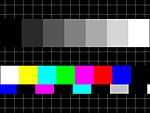Testcard

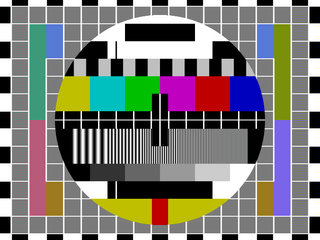
A test card, also known as a test pattern, is a television test signal, typically broadcast at times when the transmitter is active but no programme is being broadcast (often at startup and closedown). Used since the earliest TV broadcasts, test cards were originally physical cards at which a television camera was pointed, and such cards are still often used for calibration, alignment, and matching of cameras and camcorders. Test patterns used for calibrating or troubleshooting the downstream signal path are these days generated by test signal generators, which do not depend on the correct configuration (and presence) of a camera. Digitally generated cards allow vendors, viewers and television stations to adjust their equipment for optimal functionality. Test cards are typically broadcast with a sine wave reference tone or music.
Technical details
Test cards typically contain a set of patterns to enable television cameras and receivers to be adjusted to show the picture correctly (See SMPTE color bars). Most modern test cards include a set of calibrated colour bars which will produce a characteristic pattern of "dot landings" on a vectorscope, allowing chroma and tint to be precisely adjusted between generations of videotape or network feeds. SMPTE bars—and several other test cards—include analog black (a flat waveform at 7.5 [[IRE 6yfg (unit)|IRE]], or the NTSC setup level), full white (100IRE), and a "sub-black", or "blacker-than-black" (at 0 IRE), which represents the lowest low-frequency transmission voltage permissible in NTSC broadcasts (though the negative excursions of the colourburst signal may go below 0 IRE). Between the colour bars and proper adjustment of brightness and contrast controls to the limits of perception of the first sub-black bar, an analogue receiver (or other equipment such as VTRs) can be adjusted to provide impressive fidelity.
History
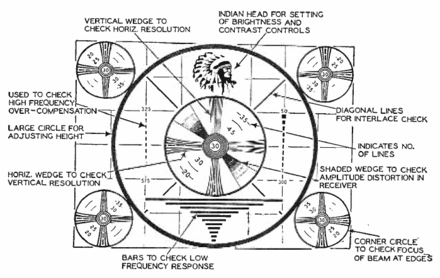
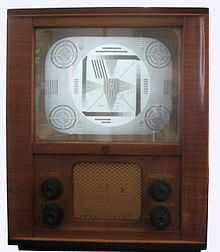
Formerly a common sight, test cards are now only rarely seen outside of television studios, post-production, and distribution facilities. In particular, they are no longer intended to assist viewers in calibration of television sets. Several things have led to their demise for this purpose:
Modern microcontroller-controlled analogue televisions rarely if ever need adjustment, so test cards are much less important than previously. Likewise, modern cameras and camcorders seldom need adjustment for technical accuracy, though they are often adjusted to compensate for scene light levels, and for various artistic effects.
Use of digital interconnect standards, such as CCIR 601 and SMPTE 292M, which operate without the non-linearities and other issues inherent to analogue broadcasting, do not introduce colour shifts or brightness changes; thus the requirement to detect and compensate for them using this reference signal has been virtually eliminated. (Compare with the obsolescence of stroboscopes as used to adjust the speed of record players). On the other hand, digital test signal generators do include test signals which are intended to stress the digital interface, and many sophisticated generators allow the insertion of jitter, bit errors, and other pathological conditions that can cause a digital interface to fail.
Likewise, use of digital broadcasting standards such as the DVB and ATSC eliminates the issues introduced by modulation and demodulation of analogue signals.
Test cards including large circles were used to confirm the linearity of the set's deflection systems. As solid-state components replaced vacuum tubes in receiver deflection circuits, linearity adjustments were less frequently required (few newer sets have user-adjustable "VERT SIZE" and "VERT LIN" controls, for example). In LCD and other deflectionless displays, the linearity is a function of the display panel's manufacturing quality; for the display to work, the tolerances will already be far tighter than human perception.
In developed countries such as the United Kingdom and the United States, the financial imperatives of commercial television broadcasting mean that air-time is now typically filled with programmes and commercials (such as infomercials) 24 hours a day, and non-commercial broadcasters have to match this.
In North America, most test cards such as the famous Indian-head test pattern of the 1950s and 1960s have long been relegated to history. The SMPTE color bars occasionally turn up, but with most North American broadcasters now following a 24-hour schedule, these too have become a rare sight.
Monoscope

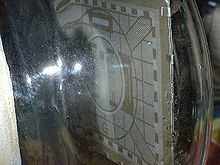
Rather than physical test cards, which had to be televised using a camera, television stations often used a special purpose camera tube which had the test pattern painted on the inside screen of the tube. Each tube was only capable of generating the one test image, hence it was called a monoscope.
Monoscopes were similar in construction to an ordinary cathode ray tube (CRT), only instead of displaying an image on its screen it scanned a built-in image. The monoscope contained a formed metal target in place of the phosphor coating at its "screen" end and as the electron beam scanned the target, rather than displaying an image, a varying electrical signal was produced generating an video signal from the etched pattern. Monoscope tubes had the advantage over test cards that a full TV camera was not needed, and the image was always properly framed and in focus. They fell out of use in the 1960s as they were not able to produce color images.
Test patterns for photocopiers
A lesser-known kind of test pattern is used for the calibration of photocopiers.[1][2] Photocopier test patterns are physical sheets that are photocopied, with the difference in the resulting photocopy revealing any telltale deviations or defects in the machine's ability to copy.
In numismatics
Television has had such an impact in today's life, that it has been the main motif for numerous collectors' coins and medals. One of the most recent ones is The 50 Years of Television commemorative coin minted on March 9, 2005 in Austria. The obverse of the coin shows a "test pattern", while the reverse shows several milestones in the history of television.
Gallery
-
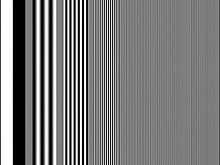
Multiburst test card
-

Philips PM5544 PAL
-
.jpg)
Philips PM5544 SECAM
-

Philips PM5544 NTSC test card used on Rajawali Televisi
-

Philips PM5538 test card
-
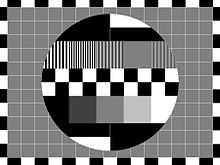
Philips PM5540 test card
-

Philips PM5522 5th generation test card
-

Satellite test card used on NET TV
-

T-Pulse test card
-

Deutscher Fernsehfunk colour test cardon
-

Deutscher Fernsehfunk monochrome test card
-

Test card used in various Australian TV stations.
-

Telefunken FuBK test card
-
Monochrome EBU test card
-

16:9 variation of Telefunken FuBK test card
-

Test card from Sjónvarpið
-
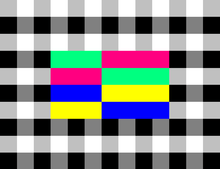
Netherlands Public Broadcasting test card
-
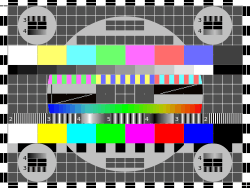
Russian test card (Ueit, УЭИТ).
-
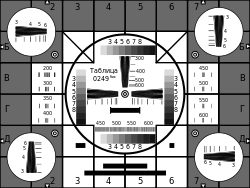
Early Soviet test card (TIT-0249BIS, ТИТ-0249бис).
-
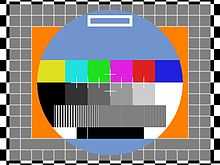
Test card used on Radiotelevisión Española
-

Test card used on Veneto
-

Test card used on Bali TV
-

Testcard used on TGRT
-
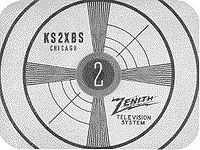
KS2XBS "Phonevision" test pattern
-

WHO-TV test pattern
See also
References
- ↑ "Samsung SF531P PCSTATS Review – Printer Test Patterns". Pcstats.com. 2007-10-15. Retrieved 2010-01-01.
- ↑ "Projection: Room A / Room B". Thing.net. Retrieved 2010-01-01.
External links
| Wikimedia Commons has media related to Test patterns. |
- STMPE Test Pattern rendered in HTML and CSS – Create Commons
- The Test Card Circle Details of the UK's Trade Test Transmissions including the history of the BBC and ITA Test Cards, a look at the music used and full details about the Trade Test Colour Films shown from the late fifties to 1973.
- mire.project – Street art work about television test patterns
- TV Testbild – very informative, but in German language only
- TestVid test card video sequences – Synthetic video test card sequences with moving elements
- Burosch AudioVideo Technology – advanced HDTV test patterns
- The Test Card Gallery
- Television Test Cards, Tuning Signals, Idents and Clocks
- Barney Wol's website has details of the development of UK testcards F, J and W
- 625.uk.com Flash Files – high quality Adobe Flash examples of almost all British test cards and station idents (the test cards are at the bottom of the page and include C, D, F, J, W and ETP-1)
- Irish TV Testcards – Pictures of Test Cards used by the Irish TV broadcasters RTÉ, TV3 and UTV.
- SVT test cards – Picture gallery of test cards from Swedish Television (SVT), in Swedish
- Russian Test Cards
- Maximum Testcardosity test cards' resources, history and galleries
- Pembers' Ponderings – Features detailed technical information of various test cards from the 30-line era to the present day, inclusive of a collection of various European test cards from 1967 to 1976.
- Taiwan TV Test card in 1990's
- Japanese monochrome test cards – Picture gallery of monochrome test cards used in Japan in the 1950s, in Japanese language only.
- DNP Electronics Standard Test Charts – Features test charts from EIA and other manufacturers a few of which were also broadcast on TV in various countries.
| ||||||||||||||||||||||||||||||


